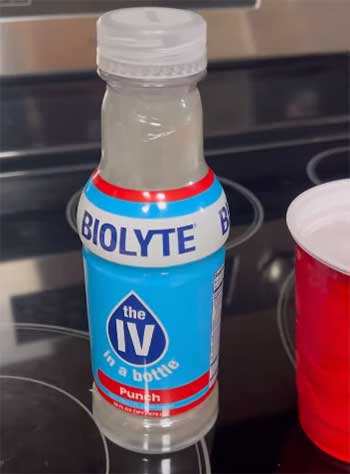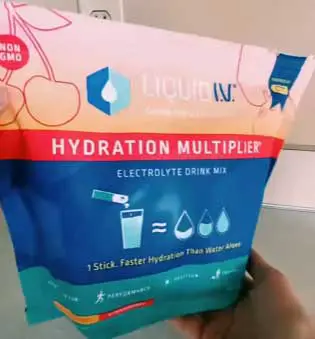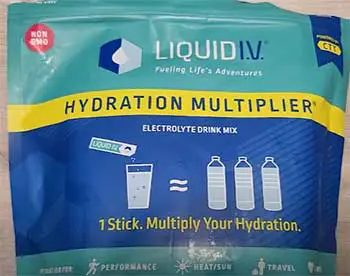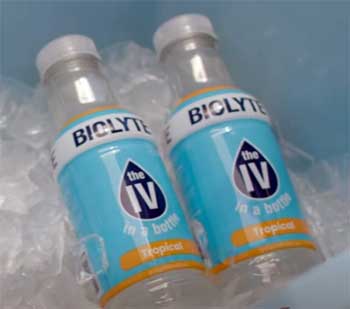I’ve always been a bit of a hydration nerd, especially after long runs or those brutal summer days when sweat seems to pour out faster than I can replace it. When I stumbled across BIOLYTE and Liquid I.V., two heavy-hitters in the electrolyte drink world, I knew I had to put them to the test.
My goal?
To figure out which one truly delivers on hydration, taste, and value. In this article, I’ll break down their pros, cons, and key features, comparing them through my own experience to help you decide which is your hydration hero.
A Brief Comparison Table
| Feature | BIOLYTE | Liquid I.V. |
| Electrolyte Content | 6.5x more than sports drinks, matches IV bag (700mg sodium, 280mg potassium) | 3x more than sports drinks (500mg sodium, 370mg potassium) |
| Sugar Content | 10g dextrose per bottle | 11g per packet (cane sugar, dextrose, stevia) |
| Flavors | 5 (Citrus, Berry, Tropical, Melon, Punch) | 16+ (e.g., Lemon Lime, Passion Fruit, Watermelon) |
| Price per Serving | ~$3.50–$3.75 (bottle), cheaper in bulk | ~$1.56–$2.40 (packet) |
| Unique Tech | Mimics IV bag formula | Cellular Transport Technology (CTT) |
| Additional Benefits | Ginger for nausea, liver-supporting nutrients | B vitamins, vitamin C, energy/sleep blends |
| Form | Ready-to-drink bottle, powder option | Powder packets |
| Dietary Notes | Keto-friendly, gluten-free, NSF-certified | Gluten-, soy-, dairy-free, non-GMO |
| Best For | Medical-grade hydration, POTS, hangovers | Versatile use, athletes, convenience |
My Journey With Hydration Drinks
Hydration isn’t just about chugging water—it’s about getting the right balance of electrolytes to keep your body firing on all cylinders. I learned this the hard way after a half-marathon left me dizzy and cramping, despite downing what felt like a gallon of H2O.
That’s when I started exploring electrolyte drinks like BIOLYTE and Liquid I.V. Both promise to hydrate faster than water alone, but they approach it differently. BIOLYTE, created by an anesthesiologist, claims to mirror an IV bag’s electrolyte profile, while Liquid I.V. leans on its Cellular Transport Technology (CTT) to speed up absorption.
I decided to try both over a month, using them during workouts, hot days, and even a rough morning after a friend’s wedding.
BIOLYTE: The IV in a Bottle

BIOLYTE markets itself as the “IV in a bottle,” and I was intrigued by its bold claim of matching the electrolyte content of a hospital-grade IV bag.
Founded by Dr. Luther Rollins, a dehydration expert, it’s designed to tackle nausea, headaches, and fatigue—symptoms I’ve battled after long runs or, let’s be honest, a night of too many cocktails.
Each 16-ounce bottle packs 700mg of sodium and 280mg of potassium, which is 6.5 times more electrolytes than your average sports drink like Gatorade.
It also includes 10g of dextrose, a simple sugar that helps shuttle electrolytes into your bloodstream.
- Pros of BIOLYTE
I was impressed by BIOLYTE’s medical-grade focus. The high sodium content (700mg per bottle) is a game-changer for intense sweat sessions or conditions like POTS (Postural Orthostatic Tachycardia Syndrome), where rapid rehydration is critical.
I tested it after a 10-mile run in 90-degree heat, and within 30 minutes, I felt less foggy and more balanced than with water alone. The inclusion of ginger for nausea relief is a thoughtful touch—I noticed it soothed my stomach after a greasy post-run burger.
BIOLYTE’s low sugar (10g per bottle) makes it keto-friendly, and it’s NSF-certified, which gave me confidence in its quality. The ready-to-drink bottles are convenient, and the powder option (recently introduced) is great for travel.
Flavors like Citrus and Berry were refreshing when chilled, especially when I froze a bottle into a slushy, as some Amazon reviewers suggested.
- Cons of BIOLYTE
The taste, though, was a mixed bag. BIOLYTE’s high sodium content gives it a salty edge, which I found jarring at first. The Citrus flavor tasted like “lemony seawater,” as one Reddit user put it, though I got used to it over time. Melon was my least favorite—too medicinal for my liking.
At $3.50–$3.75 per bottle, it’s pricier than other options, especially if you’re using it daily. Buying in bulk or at stores like Publix during sales can drop the price to around $3.50, but it still adds up. The limited flavor range (only five options) felt restrictive compared to competitors.
Some users on Amazon reported damaged bottles or leaks, which I didn’t experience but found concerning. Lastly, the high sodium might be a no-go for those with high blood pressure—always check with a doctor if you’re unsure.
Liquid I.V.: The Versatile Contender

Liquid I.V. entered the scene with a splash, boasting a wide range of products from Hydration Multiplier to Energy and Sleep Multipliers.
Its Cellular Transport Technology (CTT) uses a precise ratio of sodium (500mg), potassium (370mg), and glucose (11g) to mimic the World Health Organization’s oral rehydration solution (ORS).
I was drawn to its convenience—single-serve packets you mix with 16 ounces of water—and the dizzying array of flavors, from classics like Lemon Lime to funky ones like Seaberry and Cotton Candy. It also packs B vitamins (B3, B5, B6, B12) and vitamin C for an extra health boost.
- Pros of Liquid I.V.
Liquid I.V.’s versatility is its biggest strength. I loved tossing a packet in my gym bag for post-workout hydration or mixing the Energy Multiplier (with a caffeine kick) before a morning hike.
The flavors are a standout—Lemon Lime and Passion Fruit were crisp and refreshing, and even the polarizing Seaberry grew on me. The powder form makes it portable and easy to adjust for taste (I sometimes used less water for a stronger flavor).
At $1.56–$2.40 per packet, it’s more budget-friendly than BIOLYTE, especially for occasional use. The inclusion of B vitamins and vitamin C gave me a subtle energy lift, and I appreciated the gluten-, soy-, and dairy-free formula, which suits a wide range of diets. Liquid I.V.’s positive Amazon reviews (4.5–4.7 stars across 100,000+ reviews) echo my experience—it’s effective and tasty.
- Cons of Liquid I.V.
The 11g of sugar per packet (cane sugar, dextrose, and stevia) is a touch higher than BIOLYTE’s, which might be a dealbreaker for those watching their intake, like diabetics. Some flavors, like Concord Grape, had a chemical aftertaste that I couldn’t shake.
I also noticed mild bloating after drinking it, which some Medical News Today reviewers reported as well. The sodium (500mg) is lower than BIOLYTE’s, which could be a pro or con depending on your needs—less ideal for extreme dehydration but better for moderate activity.
While Liquid I.V. claims faster hydration than water, there’s no conclusive research proving CTT outperforms other electrolyte blends. The packets are convenient, but I wished for a ready-to-drink option for those lazy days when mixing feels like a chore.
Head-to-Head Comparison of BIOLYTE And Liquid I.V.
Let’s break this down by key factors to see how BIOLYTE and Liquid I.V. stack up in real-world scenarios.
- Electrolyte Power

BIOLYTE’s 700mg sodium and 280mg potassium per bottle outmuscle Liquid I.V.’s 500mg sodium and 370mg potassium per packet.
For context, BIOLYTE’s electrolyte profile is closer to an IV bag, making it a go-to for severe dehydration—like after a marathon or a stomach bug.
I felt this difference when I used BIOLYTE during a particularly brutal heatwave; my cramps eased faster than with Liquid I.V.
However, Liquid I.V.’s balanced potassium-to-sodium ratio is better for everyday hydration, like post-yoga or a long workday.
If you’re an endurance athlete or have a medical condition requiring high sodium, BIOLYTE has the edge. For general use, Liquid I.V. holds its own.
- Sugar and Sweetness
Both drinks keep sugar low, but BIOLYTE’s 10g of dextrose edges out Liquid I.V.’s 11g (a mix of cane sugar, dextrose, and stevia). I found BIOLYTE’s sweetness subtler, which I preferred on days when sugary drinks felt overwhelming.
Liquid I.V.’s stevia can leave an artificial aftertaste, especially in flavors like Golden Cherry. If you’re keto or sugar-conscious, BIOLYTE’s slightly lower sugar and keto-friendly claim make it a safer bet. But Liquid I.V.’s natural sweeteners appealed to me when I wanted a tastier sip without artificial junk.
- Taste and Flavor Variety
Liquid I.V. runs circles around BIOLYTE in flavor options. With 16+ choices, from Tropical Punch to Blueberry Lavender, there’s something for everyone. I loved experimenting with new flavors, though some (like Seaberry) were hit-or-miss.
BIOLYTE’s five flavors—Citrus, Berry, Tropical, Melon, and Punch—felt limited, and the salty undertone took getting used to. Chilling BIOLYTE helped, but Liquid I.V.’s flavors were consistently more drinkable.
If variety is your thing, Liquid I.V. wins hands-down. If you prefer a no-frills, medicinal taste, BIOLYTE might suit you.
- Price and Value
Price is where Liquid I.V. shines. At $1.56–$2.40 per packet, it’s significantly cheaper than BIOLYTE’s $3.50–$3.75 per bottle. I could stock up on Liquid I.V. without wincing, especially with deals on Amazon. BIOLYTE’s cost adds up fast, though bulk purchases or sales at stores like Publix can ease the sting.
For daily use, Liquid I.V. is the budget pick. But if you need BIOLYTE’s medical-grade hydration for specific scenarios (like POTS or hangovers), the price might be worth it.
- Convenience and Form
BIOLYTE’s ready-to-drink bottles are a lifesaver when I’m too wiped to mix anything. The powder option is new and promising, but I haven’t tried it yet.
Liquid I.V.’s packets are portable and easy to mix, but I occasionally forgot to pack a water bottle, leaving me stuck. For on-the-go hydration, Liquid I.V.’s packets are more versatile, but BIOLYTE’s bottles are grab-and-go perfection.
- Additional Benefits
BIOLYTE’s ginger and liver-supporting nutrients (like glucuronolactone) give it an edge for nausea relief and recovery from alcohol or illness. I found it particularly helpful after overindulging at a friend’s barbecue.
Liquid I.V.’s B vitamins and vitamin C add energy and immune support, which I noticed during flu season when I sipped the Immune Multiplier. If you want targeted relief (e.g., hangovers), BIOLYTE is better. For a broader health boost, Liquid I.V. has more to offer.
My Experience With BIOLYTE And Liquid I.V.

To really get a feel for these drinks, I used them in different scenarios.
During a 5K race, I mixed Liquid I.V.’s Passion Fruit packet into my water bottle.
It kept me hydrated without the heavy feeling of sugary sports drinks, and the flavor was a nice distraction from the grind.
BIOLYTE’s Citrus bottle was my go-to after a night out—it cut through my headache and nausea like a champ, though I had to drink it ice-cold to mask the saltiness.
For daily hydration at my desk, Liquid I.V.’s lower sodium and fun flavors made it my default. BIOLYTE felt overkill for casual use, but it was a lifesaver during a stomach bug when I couldn’t keep anything else down.
- Who Should Choose BIOLYTE?
BIOLYTE is your pick if you need serious hydration. Endurance athletes, people with medical conditions like POTS, or anyone battling severe dehydration (think flu or hangovers) will love its IV-like formula.
The ginger and low sugar make it great for sensitive stomachs or keto diets. Just be ready for the price tag and salty taste. I’d recommend it for emergencies or intense physical demands over daily sipping.
- Who Should Choose Liquid I.V.?
Liquid I.V. is the all-rounder. Its affordability, flavor variety, and portability make it ideal for athletes, busy parents, or anyone needing a hydration boost on the go. The added vitamins are a nice perk for daily wellness, and the lower sodium suits moderate activity.
If you want something tasty and versatile without breaking the bank, Liquid I.V. is your match.
Also Read: Comparison of Propel And Gatorade Zero Electrolytes.
Frequently Asked Questions (FAQ)
BIOLYTE is generally safe and effective for hydration, especially for intense exercise or medical conditions like POTS. Its high electrolyte content mimics an IV bag, aiding rapid recovery. Consult a doctor if you have high blood pressure due to its sodium content.
BIOLYTE is well-tolerated for most, but some report a salty taste or mild stomach upset. High sodium (700mg) may be risky for those with hypertension. Overconsumption (beyond 1–3 bottles daily) isn’t recommended.
Liquid I.V. edges out Hydralyte for its flavor variety and added vitamins. Hydralyte has lower sugar and is great for kids or medical use, but Liquid I.V.’s CTT and affordability make it more versatile for general hydration.
Conclusion: Your Hydration, Your Choice
You’ve got two solid contenders here, but the winner depends on you. If you’re battling extreme dehydration, need medical-grade hydration, or want a keto-friendly option, BIOLYTE’s IV-like formula is tough to beat—just brace for the cost and salty kick.
If you’re after versatility, affordability, and flavors that make hydration fun, Liquid I.V. is your go-to.
I’ve laid out the pros, cons, and my own experiences to help you pick the one that fits your life. So, grab a bottle or packet, stay hydrated, and keep crushing it.
